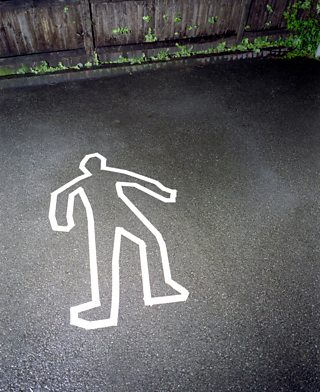Women Who Kill
The curious case of the female killer.
Written by Dr Julia Shaw, host of Bad People on Βι¶ΉΤΌΕΔ Sounds.
She was probably desperate.
This is the main assumption I hear when I enter into a conversation about a woman who has killed someone.When people talk about those who commit harmful acts, it seems easy to fall into the trap of being amateur psychologists. Nested within guesses and misconceptions, we can see sexism shine through as well.
Feminist criminologists have argued that we have a tendency to infantilise women in the criminal justice system.
Compared to men, we disproportionately treat female offenders as victims of circumstance, in need of help, and unable to support themselves in law-abiding ways. This may seem positive on the surface, but it can also reinforce the sexist narrative that women are passive actors in society while men are active.
Perhaps nowhere is this divide more evident than when we talk about women who kill.

The Gender Difference
When researchers study people who kill, we often study “intentional homicide” (referred to from now on in this article just as ‘homicide’), which is defined as unlawful death inflicted upon a person with the intent to cause death or serious injury – more commonly known as murder.
It is meaningful to examine whether gender plays a role in offending behaviour, and if it does to try to understand why.
There is also the tendency to split data into men and women. This is not because all researchers endorse a strict gender binary, but because these represent the two largest and easiest to measure groups.
Gender is also only one way to split the offending population, other characteristics like socio-economic status, mental health, and education are often more useful ways to talk about differences (or similarities) between offenders. Still, it is meaningful to examine whether gender plays a role in offending behaviour, and if it does to try to understand why.
When we look at homicide, the gender difference is stark.

Women in the UK constitute only 8% of homicide perpetrators.
According to published in 2019, 10% of suspects in intentional homicide cases worldwide were women. This rate drops even further when looking at convictions, where only 6% are women.
In the UK, , the figure is similar. Women in the UK constitute only 8% of homicide perpetrators. These figures show a clear gender imbalance, with the vast majority of homicide being perpetrated by men.
These figures seem even more stark when we consider that the proportion of women who are victims of homicide is about four times higher than the proportion who are perpetrators. For example, in 2019 in the UK, 36% of homicide victims were female. These women were most often killed by a current or former intimate partner.
This is in line with the findings that to have experienced sexual assault by a partner in the last year.
So far, everything fits with the assumption that women who kill are probably desperate, that some are women facing abuse who are finally fighting back. This is even more the case when we consider that that compared to men, women more frequently kill intimate partners in situations where the homicide victim initiated the physical aggression.

Still, we must be careful not to homogenise women who kill. Especially as we only have very limited research on women who commit homicide. Even the ONS and UN reports only describe women in any detail when they speak of victims of homicide.
This is a problem. It renders the characteristics and risk factors of women who kill largely invisible.
On this week’s episode of Bad People, myself and my podcast co-host Sofie Hagen explore two cases where women kill – a teenage girl who stabs to death a love rival at a party in plain sight, and one of Canada’s most notorious serial killers, Karla Homolka.
These cases are interesting because they don’t offer an intuitive explanation for the killings, they seemed to be planned in advance, and the victims represented no threat to them.
Motivation
Female serial killers represent one example where we break out of the assumptions we have about women who kill. Female serial killers are typically educated, have been married, and have a caregiving role.
Why did they do it? The most common answer was financial gain.
of 64 female serial killers, every female serial killer had at least one vulnerable victim – a child, an elderly person, or someone who was very ill.
Why did they do it? For revenge or protection? No. The most common motive was financial gain.
Serial killers are themselves quite rare, but these examples remind us of the need to challenge our assumptions about why, when, and whom women kill.
Female Discount
Challenging the assumptions we have about why women commit crimes does not mean we need to treat them like men.

All genders deserve our empathy and to be seen as complex human beings, even when they do bad things.
Women are more likely than men to be primary caregivers, they often have fewer financial resources, and are often in other ways more vulnerable. These factors are important, and are correctly considered when deciding sentences.
Still, there are concerns about a “female discount”.
For example, a found that women were given sentences that were on average over 60% shorter. Women who were arrested were also significantly more likely to avoid charges and convictions entirely, and twice as likely to avoid incarceration if convicted. Is this infantilising woman? Is it adversely discriminating against men? Is it fair?
My argument is not to impose longer prison terms on female offenders, or to ignore the context of homicide.
Like women, men can be victims of circumstance. Like men, women can be sadists or opportunists. And all genders deserve our empathy and to be seen as complex human beings, even when they do bad things.
Dr Julia Shaw
Dr Julia Shaw is a research associate at University College London and the co-host of the Bad People podcast on Βι¶ΉΤΌΕΔ sounds. She is an expert on criminal psychology, and the author of two international bestsellers “Making Evil: The Science Behind Humanity’s Dark Side” and “The Memory Illusion: Remembering, Forgetting, and the Science of False Memory.
Her website: www.drjuliashaw.com, and twitter @drjuliashaw




